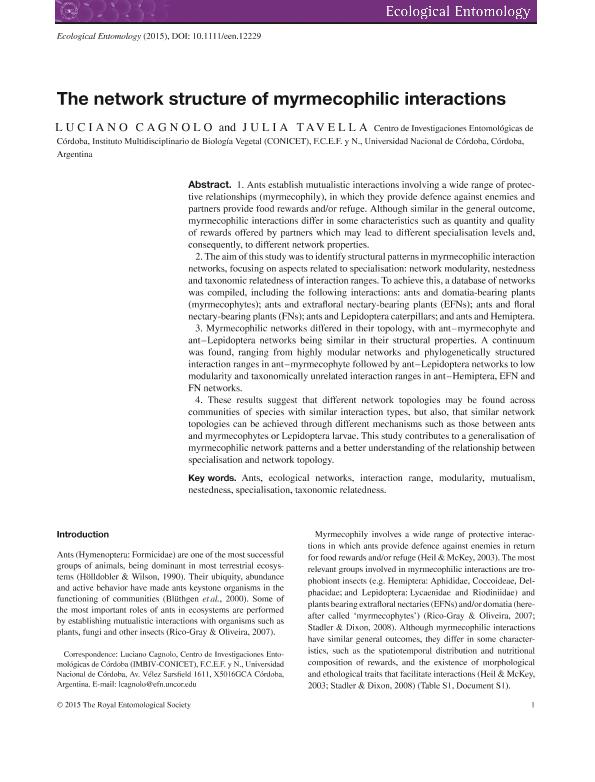Artículo
The network structure of myrmecophilic interactions
Fecha de publicación:
10/2015
Editorial:
Wiley
Revista:
Ecological Entomology
e-ISSN:
1365-2311
Idioma:
Inglés
Tipo de recurso:
Artículo publicado
Clasificación temática:
Resumen
1. Ants establish mutualistic interactions involving a wide range of protective relationships (myrmecophily), in which they provide defence against enemies and partners provide food rewards and/or refuge. Although similar in the general outcome, myrmecophilic interactions differ in some characteristics such as quantity and quality of rewards offered by partners which may lead to different specialisation levels and, consequently, to different network properties.
2. The aim of this study was to identify structural patterns in myrmecophilic interaction networks, focusing on aspects related to specialisation: network modularity, nestedness and taxonomic relatedness of interaction ranges. To achieve this, a database of networks was compiled, including the following interactions: ants and domatia-bearing plants (myrmecophytes); ants and extrafloral nectary-bearing plants (EFNs); ants and floral nectary-bearing plants (FNs); ants and Lepidoptera caterpillars; and ants and Hemiptera.
3. Myrmecophilic networks differed in their topology, with ant–myrmecophyte and ant–Lepidoptera networks being similar in their structural properties. A continuum was found, ranging from highly modular networks and phylogenetically structured interaction ranges in ant–myrmecophyte followed by ant–Lepidoptera networks to low modularity and taxonomically unrelated interaction ranges in ant–Hemiptera, EFN and FN networks.
4. These results suggest that different network topologies may be found across communities of species with similar interaction types, but also, that similar network topologies can be achieved through different mechanisms such as those between ants and myrmecophytes or Lepidoptera larvae. This study contributes to a generalisation of myrmecophilic network patterns and a better understanding of the relationship between specialisation and network topology.
Palabras clave:
Ants
,
Ecological Networks
,
Interaction Range
,
Modularity
Archivos asociados
Licencia
Identificadores
Colecciones
Articulos(IMBIV)
Articulos de INST.MULTIDISCIPL.DE BIOLOGIA VEGETAL (P)
Articulos de INST.MULTIDISCIPL.DE BIOLOGIA VEGETAL (P)
Citación
Cagnolo, Luciano; Tavella, Julia Rita; The network structure of myrmecophilic interactions; Wiley; Ecological Entomology; 40; 5; 10-2015; 553-561
Compartir
Altmétricas




